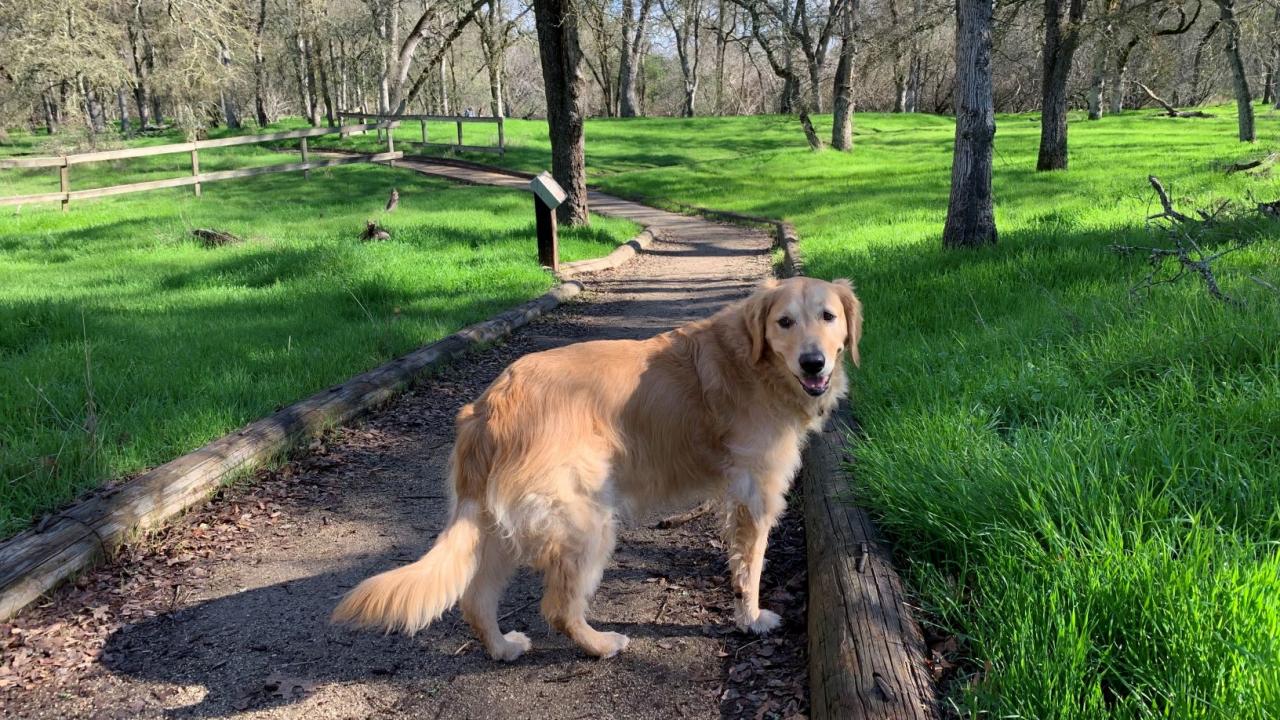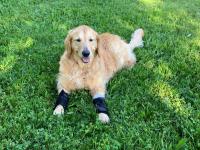
Unique Surgical Solutions Help Heal Dog’s Injured Wrists
“Case of the Month” – March 2021
Starlit Sky, 7-year-old female golden retriever, has not had it easy over the past three years since an initial injury to her front left carpus (wrist). Suspected of slipping on a tile floor, she hyperextended the carpal joint which caused her paw to collapse under her leg. The injury was so severe that one veterinarian suggested amputation. Several failed surgeries and a similar injury to her right leg for overcompensation left Starlit Sky in a constant state of pain – wearing braces and enduring rigorous rehabilitation activities, none of which seemed to ultimately solve the problems. Determined to not have this be her fate in life, Starlit Sky’s owner Patricia Chiara took their physical therapist’s advice and brought her to the UC Davis veterinary hospital for an evaluation.

Faculty surgeon Dr. Barbro Filliquist and surgery resident Dr. Karen Park took the lead on Starlit Sky’s case, assessing her multiple orthopedic abnormalities. They observed permanent changes to her wrists, which were painful and abnormally angled. They knew that she required surgery that would fix the joint in place. Due to the nature of the damage, any surgical solution could never result in a normal joint, but the surgeons were confident that it could significantly reduce pain and assist in a more normal gait. To accomplish this, they would implement some unique surgical solutions to Starlit Sky’s ongoing problems.
For nearly a decade, UC Davis has utilized a bone growth promoter called bone morphogenetic protein (BMP) to heal and regrow bone in dogs. The growth-promoting protein stimulates a dog’s healthy bone tissue in an injured area to grow new bone cells and integrate with the native bone, eventually filling in an entire defect area or helping to fuse a joint. The goal for Starlit Sky was to use BMP to help fuse her carpal joint enough for it to bare the weight of her body again.
In surgery on her left leg, the bones that make up the carpal joint (metacarpals, carpals, and radius) were fused together using a metal plate implant and additionally with BMP placed in the gap between her radius and carpus to promote bone growth. Drs. Filliquist and Park also infused an antibiotic gel into the wound, in the event there was an underlying infection that would compromise healing. Post-operative X-rays showed that the metal implant and screws were properly in place.

Starlit Sky healed well, and the BMP worked as planned. Following 10 weeks of recovery, she returned to UC Davis for a similar procedure on her right wrist. However, on the second surgery, the doctors decided to use a bone graft instead of BMP, along with a metal plate implant similar to the one in her left leg. Bone marrow was extracted from her humerus and placed into the joint to aid in bone fusion.
During both recovery periods, Starlit Sky was restricted to kennel confinement with extremely limited activity. The surgeons warned that too much activity before complete bone healing can lead to failure of the surgical implants or delayed healing, which may require prolonged activity restrictions or another surgery. Chiara diligently restricted Starlit Sky’s activity for 15 weeks until she was cleared to slowly return to normal activity.
While she is still not fully recovered in the right joint, she is showing mildly improved bone fusion. Her doctors are hopeful that no further surgeries will be needed.
Happy with the outcome, Chiara has noticed a marked improvement in Starlit Sky’s life.
“Her quality of life now is so much better than it has been in the past three years,” said Chiara. “It’s night and day!”
# # #
Starlight Sky’s care showcases an example of innovative procedures that will be a hallmark of the future Veterinary Medical Center at UC Davis. As the final phase of the VMC, an entirely new Small Animal Hospital will be constructed, expanding the size and scope of the current facility. This will allow clinicians to expand their cutting-edge procedures and continue to push the limits of veterinary medicine.
